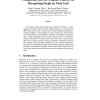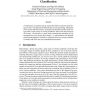113
click to vote
BMVC
1998
15 years 2 months ago
1998
An approach to gesture recognition is presented in which gestures are modelled probabilistically as sequences of visual events. These events are matched to visual input using prob...
BMVC
1998
15 years 2 months ago
1998
In the paper we present the Progressive Probabilistic Hough Transform (PPHT). Unlike the Probabilistic Hough Transform 4] where Standard Hough Transform is performed on a pre-sele...
110
Voted
BMVC
1998
15 years 2 months ago
1998
We introduce an object recognition system in which objects are represented as a sparse and spatially organized set of local (bent) line segments. The line segments correspond to b...
108
click to vote
BMVC
1998
15 years 2 months ago
1998
A method of extracting, classifying and modelling non-rigid shapes from an image sequence is presented. Shapes are approximated by polygons where the number of sides is related to...
102
click to vote
BMVC
1998
15 years 2 months ago
1998
This paper describes how corner detection can be realised using a new feature representation that has recently been successfully exploited for edge and symmetry detection. The fea...
127
click to vote
BMVC
1998
15 years 2 months ago
1998
To recognize people by their gait from a sequence of images, we have proposed a statistical approach which combined eigenspace transformation (EST) with canonical space transforma...
132
Voted
BMVC
1998
15 years 2 months ago
1998
We consider reconstruction algorithms using points tracked over a sequence of (at least three) images, to estimate the positions of the cameras (motion parameters), the 3D coordin...
110
click to vote
BMVC
1998
15 years 2 months ago
1998
A working face recognition system requires the ability to represent facial images in such a way that permits efficient and accurate processing. The human visual system effectively...
BMVC
1998
15 years 2 months ago
1998
Mosaic techniques have been used to obtain images with a large field of view from video sequences by assembling individual overlapping images. In existing methods of mosaic constr...
107
click to vote
BMVC
1998
15 years 2 months ago
1998
We present a method for learning appearance models that can be used to recognise and track both 3D head pose and identities of novel subjects with continuous head movement across ...


